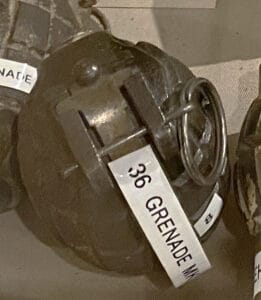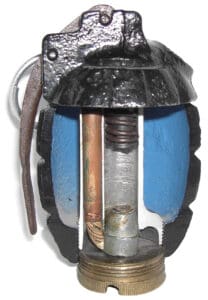A 4 inch by 2.75 inch diameter metal grenade.
The Mills was a classic design; a grooved cast iron “pineapple” with a central striker held by a close hand lever and secured with a pin. According to Mills’s notes, the casing was grooved to make it easier to grip, not as an aid to fragmentation; and it has been shown that it does not shatter along the segmented lines.
The Mills bomb underwent numerous modifications. The No. 23 was a No. 5 with a rodded base plug which allowed it to be fired from a rifle. This concept evolved further with the No. 36, a variant with a detachable base plate for use with a rifle discharger cup. The final variation of the Mills bomb, the No. 36M, was specially designed and waterproofed with shellac for use in the hot climate of Mesopotamia in 1917 at first but remained in production for many years.[4] By 1918 the No. 5 and No. 23 had been declared obsolete and the No. 36 (but not the 36M) followed in 1932.


